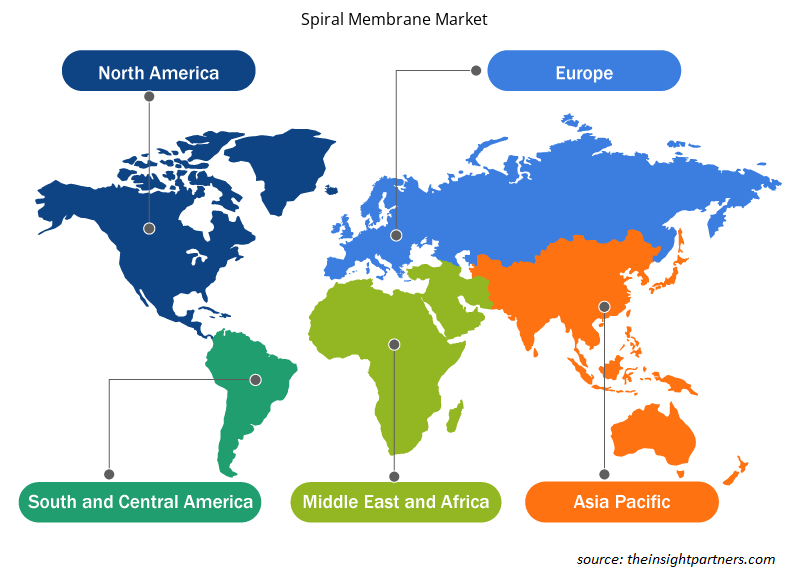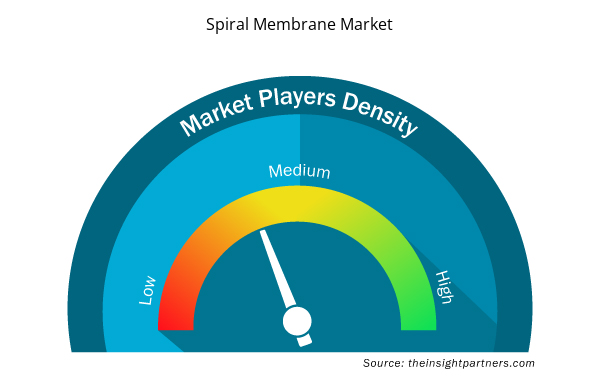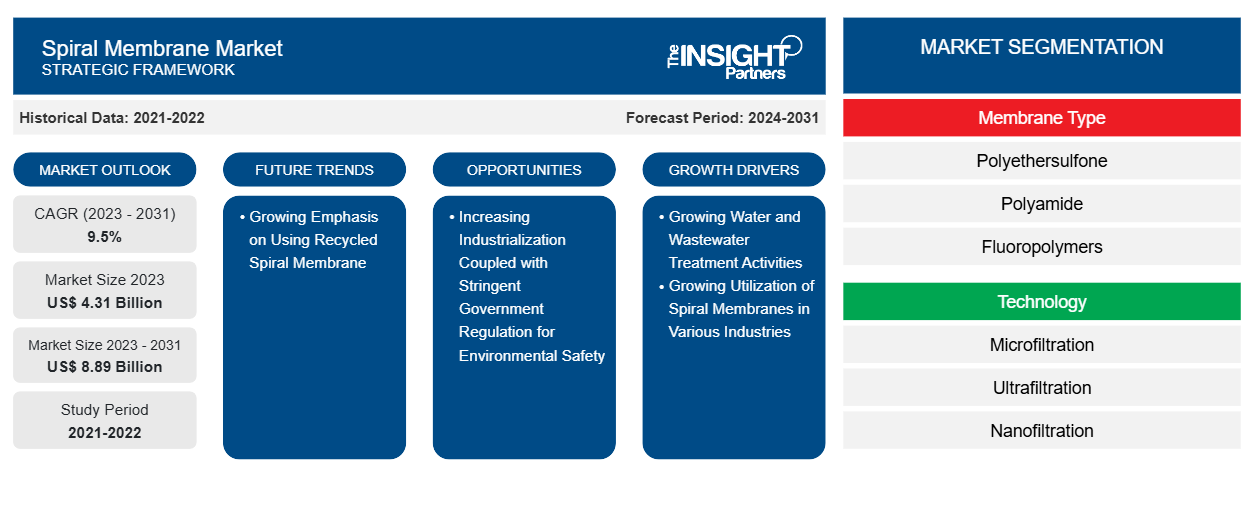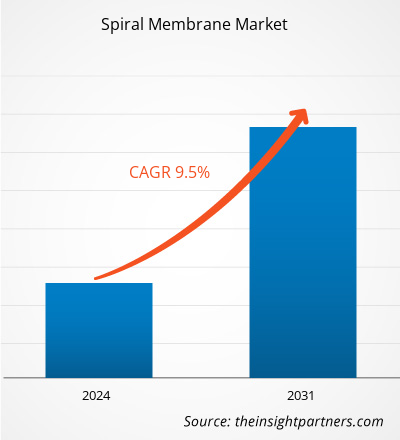预计到 2031 年,螺旋膜市场规模将从 2023 年的 43.1 亿美元增至 88.9 亿美元。预计 2023-2031 年期间,该市场的复合年增长率将达到 9.5%。由于对水和废水处理的需求不断增长,螺旋膜在世界各地受到欢迎。由于螺旋膜有助于达到高质量的水净化标准,因此其在各个行业的应用趋势日益明显。
螺旋膜市场分析
全球许多国家的政府都在鼓励水和废水处理实践。欧洲各国正致力于实现废水处理目标、保护敏感的水系统和利用废水污泥。螺旋膜能够实现食品饮料、化学品、生物技术和制药行业产品的高产浓缩和脱盐,使其成为这些行业过滤用途的合适替代品。此外,政府通过对制造业实施监管来实现环境安全和可持续发展目标的举措不断增多,这也增加了过滤工艺的采用。
螺旋膜市场概况
螺旋膜是一种紧密包装的过滤介质,其中渗透膜以螺旋方式缠绕在中心芯上,这类似于织物卷。它由平板膜、垫片和多孔渗透流材料夹层组成,包裹在中心渗透液收集管周围。渗透膜在边缘处密封,并与垫片材料间隙,以允许要过滤的液体流动。螺旋膜因其过滤效率而广泛应用于市政水处理应用。螺旋膜的较高填充密度增强了过滤能力和分离性能,从而导致需求增加。2024 年 4 月,东丽工业公司获得了香港将军澳海水淡化厂的反渗透膜订单,标志着该公司成功为全球海水淡化厂供应 RO 膜并为稳定运营提供技术支持。
定制此报告以满足您的需求
您可以免费定制任何报告,包括本报告的部分内容、国家级分析、Excel 数据包,以及为初创企业和大学提供优惠和折扣
- 获取此报告的关键市场趋势。这个免费样品将包括数据分析,从市场趋势到估计和预测。
螺旋膜市场驱动因素和机遇
螺旋膜在各行各业的应用日益广泛
螺旋缠绕元件由膜、进料隔板、渗透隔板和渗透管组成。渗透膜以螺旋状缠绕在中心芯上,边缘密封。用隔板材料形成间隙,以允许液体流动进行过滤。由于螺旋膜有助于实现食品和饮料、化学品、生物技术和制药行业产品的高产量浓缩和脱盐,因此它们是工业过滤目的最合适的替代品。螺旋缠绕模块与反渗透、纳滤和其他先进的膜技术相结合,以实现所需的水纯度水平。
在食品和饮料行业中,螺旋膜充当选择性屏障,允许水分子通过,同时保留任何污染物。这使得净化过程非常高效,从而有助于生产具有优质口味、质量和保质期的食品和饮料。与其他过滤技术相比,螺旋膜的紧凑设计降低了能耗。螺旋膜是有益的,特别是对于以能源效率为关键考虑因素的行业,既有助于节约经济,又能减少对环境的影响。此外,制药行业在过滤过程中使用螺旋膜来减少加工水和药品中的内毒素。这些膜可用于净化、浓缩和分离人体血液成分。此外,螺旋膜具有出色的化学和热稳定性,具有高 pH 值和耐高温性。螺旋膜的优势使其适用于各种应用,如乳清蛋白浓缩、乳糖浓缩、阴极/阳极涂料回收、染料脱盐和浓缩、硫酸盐去除和废水中的油分离。因此,螺旋膜在各个行业中的应用日益广泛,推动了市场的发展。
工业化进程加快,政府对环境安全监管趋严
后疫情时代,巨大的投资前景和商业模式的重组是推动工业化快速发展的主要因素。随着发展中经济体经历重大转型,制造业、建筑业和工业部门快速增长,对过滤解决方案的依赖变得至关重要。根据中国国务院新闻办公室 (SCIO) 2022 年发布的数据,中国工业产出比上一年增长了 3.6%。随着生产活动的激增,制造过程中对过滤的需求也随之增加,这需要高效的过滤膜。因此,螺旋膜的需求不断增加,以确保工业废物处理等工业过程中的最佳性能和过滤效率。这些膜广泛用于石油和天然气、纺织、造纸和纸浆、化学品、石化产品、食品和饮料以及制药等各个行业的纳滤或反渗透。此外,政府通过对制造业实施监管来实现环境安全和可持续发展目标的举措不断增多,这也增加了过滤工艺的采用。因此,中国对清洁和循环水技术(如螺旋膜组件)的需求正在增长。中国政府已设定目标,在所有城市处理 95% 的废水,并在水容量低的地区实现 25% 的水再利用率。此外,《清洁水法案》 (CWA) 为监测美国水体污染物排放建立了基本结构。此外,印度政府还实施了多项环境法规,以保护环境并控制日益严重的污染水平。印度出台了 1974 年《水法》、1981 年《空气法》和 1986 年《环境法》等法规,旨在为印度提供更清洁的环境。因此,预计发展中经济体的快速工业化和政府对环境安全的严格监管将在预测期内为螺旋膜市场增长创造丰厚的机会。
螺旋膜市场报告细分分析
有助于得出螺旋膜市场分析的关键部分是膜类型、技术和最终用户。
- 根据膜类型,螺旋膜市场细分为聚醚砜、聚酰胺、含氟聚合物等。聚酰胺部分在 2023 年占据了最大的市场份额。
- 根据技术,市场分为微滤、超滤、纳滤和反渗透。反渗透部分在 2023 年占据了最大的市场份额。
就最终用户而言,市场细分为食品和饮料、生物技术和生物化学、制药和医疗保健、水处理(市政)、废水(工业)、化学品、石油和天然气、纺织/纸浆和造纸行业等。2023 年,水处理(市政)领域占据了市场主导地位。
螺旋膜市场份额按地区分析
螺旋膜市场报告的地理范围主要分为五个区域:北美、亚太、欧洲、中东和非洲、南美和中美。
2023 年,亚太地区占据了螺旋膜市场份额的主导地位。近年来,亚太地区对石油和天然气的需求一直在迅速增长。根据国际能源署的数据,全球石油需求在 2021 年反弹,预计到 2025 年该地区将占石油需求增长的 77%。随着该地区各国经历快速的工业化和经济增长,对石油和天然气的需求也在增加。勘探、开采和炼制过程会产生大量含有各种污染物的废水,包括碳氢化合物、重金属和悬浮固体。螺旋膜在处理这些复杂的废水方面非常有效,可确保水质在排放或再利用之前符合严格的环境法规,从而最大限度地减少对环境的影响。因此,亚太地区石油和天然气行业对各种应用的适当废水管理的需求日益增加。
螺旋膜市场区域洞察
Insight Partners 的分析师已详细解释了预测期内影响螺旋膜市场的区域趋势和因素。本节还讨论了北美、欧洲、亚太地区、中东和非洲以及南美和中美洲的螺旋膜市场细分和地理位置。

- 获取螺旋膜市场的区域特定数据
螺旋膜市场报告范围
| 报告属性 | 细节 |
|---|---|
| 2023 年的市场规模 | 43.1亿美元 |
| 2031 年市场规模 | 88.9 亿美元 |
| 全球复合年增长率(2023 - 2031) | 9.5% |
| 史料 | 2021-2022 |
| 预测期 | 2024-2031 |
| 涵盖的领域 | 按膜类型
|
| 覆盖地区和国家 | 北美
|
| 市场领导者和主要公司简介 |
|
螺旋膜市场参与者密度:了解其对业务动态的影响
螺旋膜市场正在快速增长,这得益于终端用户需求的不断增长,这些需求源于消费者偏好的不断变化、技术进步以及对产品优势的认识不断提高等因素。随着需求的增加,企业正在扩大其产品范围,进行创新以满足消费者的需求,并利用新兴趋势,从而进一步推动市场增长。
市场参与者密度是指在特定市场或行业内运营的企业或公司的分布情况。它表明在给定市场空间中,相对于其规模或总市场价值,有多少竞争对手(市场参与者)存在。
在螺旋膜市场运营的主要公司有:
- 阿法拉伐公司
- 东丽工业公司
- GEA 集团
- 曼胡默尔国际有限公司
- 杜邦公司
- 滨特尔公司
免责声明:上面列出的公司没有按照任何特定顺序排列。

- 了解螺旋膜市场主要参与者概况
螺旋膜市场新闻和最新发展
通过收集一手和二手研究后的定性和定量数据来评估螺旋膜市场,其中包括重要的公司出版物、协会数据和数据库。以下列出了螺旋膜市场的一些发展情况:
- 东丽工业开发了一种耐用的反渗透膜,可确保长期水质并保持出色的去除性能,适用于工业废水处理。(来源:东丽工业,新闻稿,2024 年 3 月)
- 威立雅水务技术公司签署协议,扩大其在中国无锡的业务,并与无锡国家高新技术产业开发区管理委员会合作。(来源:威立雅水务技术公司,新闻稿,2024 年 5 月)
- Sun Capital Partners 收购了科赫工业旗下的 Koch Separation Solutions,并将其改组为 Kovalus Separation Solutions。(来源:Sun Capital Partners,新闻稿,2023 年 10 月)
- Solecta Inc. 和路博润公司宣布建立新的合作伙伴关系,以开发和销售新型膜解决方案,从而提高全球分离行业的生产力和效率。(来源:Solecta Inc,公司网站,2023 年 2 月)
螺旋膜市场报告范围和交付成果
“螺旋膜市场规模和预测(2021-2031)”报告对以下领域进行了详细的市场分析:
- 范围内涵盖的所有主要细分市场的全球、区域和国家层面的螺旋膜市场规模和预测
- 螺旋膜市场趋势以及市场动态,如驱动因素、限制因素和关键机遇
- 详细的波特五力分析和 SWOT 分析
- 螺旋膜市场分析涵盖主要市场趋势、全球和区域框架、主要参与者、法规和最新市场发展
- 行业格局和竞争分析,涵盖市场集中度、热点图分析、知名企业以及螺旋膜市场的最新发展
- 详细的公司简介
- 历史分析(2 年)、基准年、预测(7 年)及复合年增长率
- PEST 和 SWOT 分析
- 市场规模价值/数量 - 全球、区域、国家
- 行业和竞争格局
- Excel 数据集


- Medical Collagen Market
- Single-Use Negative Pressure Wound Therapy Devices Market
- Influenza Vaccines Market
- Smart Grid Sensors Market
- Equipment Rental Software Market
- Cling Films Market
- Adaptive Traffic Control System Market
- Ceramic Injection Molding Market
- Sports Technology Market
- Mice Model Market

Report Coverage
Revenue forecast, Company Analysis, Industry landscape, Growth factors, and Trends

Segment Covered
This text is related
to segments covered.

Regional Scope
North America, Europe, Asia Pacific, Middle East & Africa, South & Central America

Country Scope
This text is related
to country scope.
常见问题
Asia Pacific has been noticed as one of the prominent markets for the utilization of spiral membranes owing to the growing chemical, pharmaceutical, and oil & gas sectors and rising urbanization leading to increasing demand for water and wastewater treatment. Moreover, government initiatives and policies such as Make in India encourage the setup of different manufacturing plants in India.
Based on technology, the market is categorized into microfiltration, ultrafiltration, nanofiltration, and reverse osmosis. In 2023, the reverse osmosis segment is expected to grow at fastest CAGR during the forecast period. Reverse osmosis (RO) technology is a widely used method for purifying water by removing dissolved salts, contaminants, and other impurities.
Governments of many countries worldwide are encouraging water and wastewater treatment practices. Various countries in Europe are working toward achieving wastewater treatment targets, protecting sensitive water systems, and utilizing wastewater sludge. According to the European Environment Agency (EEA) published data in 2021, the collection and treatment of wastewater are improving across the region.
The major players operating in the global spiral membrane market are Alfa Laval AB, Toray Industries Inc, GEA Group, MANN+HUMMEL International GmbH & Co. KG, DuPont de Nemours Inc, Pentair Plc, PCI Membranes, Solecta, Inc., atech innovations GmbH, Kovalus Separation Solutions Inc, TAMI Industries S.A.S, Synder Filtration Inc, UNISOL Membrane Technology, Membranium, AXEON Water Technologies, Inopor, Nitto Denko Corporation, Veolia Environnement SA, and Membracon (UK) Ltd..
Based on membrane type, the spiral membrane market is segmented into polyethersulfone, polyamide, fluoropolymers, and others. In 2023, the polyamide segment held the largest market share. Polyamide membranes are composed of polyamide, a type of polymer known for its high mechanical strength, chemical resistance, and excellent filtration properties.
Significant investment prospects and restructured business models in the post-pandemic scenario are the main factors contributing to rapid industrialization. As developing economies undergo significant transformation, with rapid growth in manufacturing, construction, and industrial sectors, the reliance on filtration solutions becomes paramount. As per the data published by State Council Information Office of China (SCIO) in 2022, industrial output in China increased by 3.6% from the previous year.
Trends and growth analysis reports related to Chemicals and Materials : READ MORE..
The List of Companies - Spiral Membrane Market
- Alfa Laval AB
- Toray Industries Inc
- GEA Group
- MANN+HUMMEL International GmbH & Co. KG
- DuPont de Nemours Inc
- Pentair Plc
- PCI Membranes
- Solecta, Inc.
- Atech Innovations GmbH
- Kovalus Separation Solutions Inc
The Insight Partners performs research in 4 major stages: Data Collection & Secondary Research, Primary Research, Data Analysis and Data Triangulation & Final Review.
- Data Collection and Secondary Research:
As a market research and consulting firm operating from a decade, we have published and advised several client across the globe. First step for any study will start with an assessment of currently available data and insights from existing reports. Further, historical and current market information is collected from Investor Presentations, Annual Reports, SEC Filings, etc., and other information related to company’s performance and market positioning are gathered from Paid Databases (Factiva, Hoovers, and Reuters) and various other publications available in public domain.
Several associations trade associates, technical forums, institutes, societies and organization are accessed to gain technical as well as market related insights through their publications such as research papers, blogs and press releases related to the studies are referred to get cues about the market. Further, white papers, journals, magazines, and other news articles published in last 3 years are scrutinized and analyzed to understand the current market trends.
- Primary Research:
The primarily interview analysis comprise of data obtained from industry participants interview and answers to survey questions gathered by in-house primary team.
For primary research, interviews are conducted with industry experts/CEOs/Marketing Managers/VPs/Subject Matter Experts from both demand and supply side to get a 360-degree view of the market. The primary team conducts several interviews based on the complexity of the markets to understand the various market trends and dynamics which makes research more credible and precise.
A typical research interview fulfils the following functions:
- Provides first-hand information on the market size, market trends, growth trends, competitive landscape, and outlook
- Validates and strengthens in-house secondary research findings
- Develops the analysis team’s expertise and market understanding
Primary research involves email interactions and telephone interviews for each market, category, segment, and sub-segment across geographies. The participants who typically take part in such a process include, but are not limited to:
- Industry participants: VPs, business development managers, market intelligence managers and national sales managers
- Outside experts: Valuation experts, research analysts and key opinion leaders specializing in the electronics and semiconductor industry.
Below is the breakup of our primary respondents by company, designation, and region:

Once we receive the confirmation from primary research sources or primary respondents, we finalize the base year market estimation and forecast the data as per the macroeconomic and microeconomic factors assessed during data collection.
- Data Analysis:
Once data is validated through both secondary as well as primary respondents, we finalize the market estimations by hypothesis formulation and factor analysis at regional and country level.
- Macro-Economic Factor Analysis:
We analyse macroeconomic indicators such the gross domestic product (GDP), increase in the demand for goods and services across industries, technological advancement, regional economic growth, governmental policies, the influence of COVID-19, PEST analysis, and other aspects. This analysis aids in setting benchmarks for various nations/regions and approximating market splits. Additionally, the general trend of the aforementioned components aid in determining the market's development possibilities.
- Country Level Data:
Various factors that are especially aligned to the country are taken into account to determine the market size for a certain area and country, including the presence of vendors, such as headquarters and offices, the country's GDP, demand patterns, and industry growth. To comprehend the market dynamics for the nation, a number of growth variables, inhibitors, application areas, and current market trends are researched. The aforementioned elements aid in determining the country's overall market's growth potential.
- Company Profile:
The “Table of Contents” is formulated by listing and analyzing more than 25 - 30 companies operating in the market ecosystem across geographies. However, we profile only 10 companies as a standard practice in our syndicate reports. These 10 companies comprise leading, emerging, and regional players. Nonetheless, our analysis is not restricted to the 10 listed companies, we also analyze other companies present in the market to develop a holistic view and understand the prevailing trends. The “Company Profiles” section in the report covers key facts, business description, products & services, financial information, SWOT analysis, and key developments. The financial information presented is extracted from the annual reports and official documents of the publicly listed companies. Upon collecting the information for the sections of respective companies, we verify them via various primary sources and then compile the data in respective company profiles. The company level information helps us in deriving the base number as well as in forecasting the market size.
- Developing Base Number:
Aggregation of sales statistics (2020-2022) and macro-economic factor, and other secondary and primary research insights are utilized to arrive at base number and related market shares for 2022. The data gaps are identified in this step and relevant market data is analyzed, collected from paid primary interviews or databases. On finalizing the base year market size, forecasts are developed on the basis of macro-economic, industry and market growth factors and company level analysis.
- Data Triangulation and Final Review:
The market findings and base year market size calculations are validated from supply as well as demand side. Demand side validations are based on macro-economic factor analysis and benchmarks for respective regions and countries. In case of supply side validations, revenues of major companies are estimated (in case not available) based on industry benchmark, approximate number of employees, product portfolio, and primary interviews revenues are gathered. Further revenue from target product/service segment is assessed to avoid overshooting of market statistics. In case of heavy deviations between supply and demand side values, all thes steps are repeated to achieve synchronization.
We follow an iterative model, wherein we share our research findings with Subject Matter Experts (SME’s) and Key Opinion Leaders (KOLs) until consensus view of the market is not formulated – this model negates any drastic deviation in the opinions of experts. Only validated and universally acceptable research findings are quoted in our reports.
We have important check points that we use to validate our research findings – which we call – data triangulation, where we validate the information, we generate from secondary sources with primary interviews and then we re-validate with our internal data bases and Subject matter experts. This comprehensive model enables us to deliver high quality, reliable data in shortest possible time.


 获取此报告的免费样本
获取此报告的免费样本